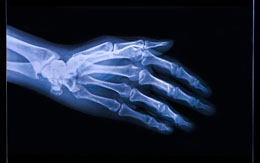Once considered to be a fatal condition, osteomyelitis is largely treatable nowadays. This article provides some information about this medical condition, its symptoms and causes, as well as the prevention and treatment of the same.

Osteomyelitis refers to a condition wherein there is an infection and inflammation in the bone or bone marrow. Since bones are made up of living cells, they can get infected through external agents. The infecting agents can reach the bone through the blood or through direct means, especially if there is an injury where the bone is exposed. External germs might enter into the bone region and cause infections, most of which can be fatal.
Due to the nature of the infection, it is mostly the long bones that are affected. The common bones where this occurs are femur (the long thigh bone) and humerus (the long upper arm bone). Infections can also occur in the pelvic girdle, the clavicle (collarbone), the spine, the phalanges of the foot, and the carpals and the tarsals of the hands and feet.
There is no age propensity for this medical condition, because it is an infection that can occur in people of any age. However, because the bones in children and people above the age of fifty years are more vulnerable, these groups of people are more at risk.
Symptoms
Though it is a bone condition, the symptoms of this disease are not restricted to the skeleton. There are many signs and symptoms that are evident all over the body and they are different in children and in adults.
In children, there might be short-term fevers that intermittently come and go, a severe pain where the infection has occurred, and also externally visible signs such as redness and swelling at the point of infection. One would also find the affected area to be warmer to the touch than the rest of the body. These children would become inactive and would become highly irritable.
Adults have most of the same conditions, but they would be to a much severe degree. These adults would also have a presence of pus-like drainage from the wound that is associated with the infection (in cases of bone infections caused due to trauma).
Furthermore, this medical condition can happen without any external signs and symptoms too, and this generally happens if the person hasn't had any visible injury as the cause of the infection. The only indication that might be perceivable in such cases is an acute pain in the area of the infection.
Causes
This medical condition is caused, in most cases, by a bacterium called Staphylococcus aureus. Furthermore, various kinds of infections contribute to this disease. Some of these infections are as follows:-
- Infections might occur due to an injury, which may cause external germs to come into contact with the bone.
- Problems with surgery, such as using unclean instruments especially in using metal fixtures for the bones, might cause infections to the bones.
- Some infections can happen through the bloodstream. This happens more in children, and are commonly brought in by infections through the respiratory system and the urinary tract.
- If the person has problems with blood circulation, the white blood corpuscles cannot reach the bone areas. This can cause pathogens to subsist within them, causing fatal infections.
Risks
Those who get infected easily due to an inferior constitution of their blood have a higher risk of this disease. They must be on their guard when they have injuries to their bones or when they undergo some bone surgeries. Also, those consuming drugs and who have had to use tubes for intravenous entry into their bodies, such as during dialysis, are at a greater risk of this disease.
Prevention
People with low blood circulation and a higher chance of infections should always be very careful about their bodies. They must take care that they are not injured often, and also make sure not to keep any wounds open on their bodies. Such conditions must be revealed to the surgeon if the person has to undergo any surgery.
Treatment
This medical condition is very difficult to treat, mostly because it is difficult to stop the infection from spreading to the other bones. Also, bone cells are not as receptive to antibiotics as the other cells of the body are. However, this treatment would involve antibiotics, surgery, or both of these. Blood tests, X-rays, and MRI scans may be conducted. Further, the type of organism causing the infection would also have to be determined, so that the doctor can prescribe the right medication. The doctor would try to stop the infection from spreading with aggressive antibiotic methods. Quite often, antibiotics help bring the infection under control and thus, one can avoid surgery. However, if the situation has exacerbated to severe degrees, the bone might be removed from the body and replaced with a metal rod. It is more difficult to treat this disease in adults than in children.
Disclaimer:
This Buzzle article is for informative purposes only, and should not be used as a replacement for expert medical advice.


 Osteomyelitis refers to a condition wherein there is an infection and inflammation in the bone or bone marrow. Since bones are made up of living cells, they can get infected through external agents. The infecting agents can reach the bone through the blood or through direct means, especially if there is an injury where the bone is exposed. External germs might enter into the bone region and cause infections, most of which can be fatal.
Osteomyelitis refers to a condition wherein there is an infection and inflammation in the bone or bone marrow. Since bones are made up of living cells, they can get infected through external agents. The infecting agents can reach the bone through the blood or through direct means, especially if there is an injury where the bone is exposed. External germs might enter into the bone region and cause infections, most of which can be fatal.